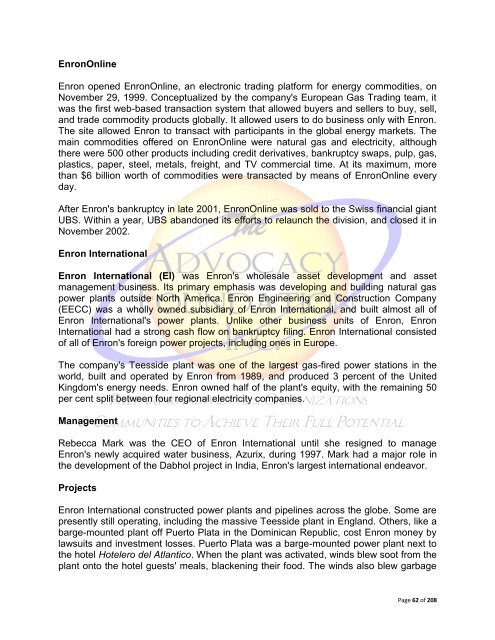The Sarbanes-Oxley Act of 2002
The Sarbanes-Oxley Act of 2002
The Sarbanes-Oxley Act of 2002
You also want an ePaper? Increase the reach of your titles
YUMPU automatically turns print PDFs into web optimized ePapers that Google loves.
EnronOnline<br />
Enron opened EnronOnline, an electronic trading platform for energy commodities, on<br />
November 29, 1999. Conceptualized by the company's European Gas Trading team, it<br />
was the first web-based transaction system that allowed buyers and sellers to buy, sell,<br />
and trade commodity products globally. It allowed users to do business only with Enron.<br />
<strong>The</strong> site allowed Enron to transact with participants in the global energy markets. <strong>The</strong><br />
main commodities <strong>of</strong>fered on EnronOnline were natural gas and electricity, although<br />
there were 500 other products including credit derivatives, bankruptcy swaps, pulp, gas,<br />
plastics, paper, steel, metals, freight, and TV commercial time. At its maximum, more<br />
than $6 billion worth <strong>of</strong> commodities were transacted by means <strong>of</strong> EnronOnline every<br />
day.<br />
After Enron's bankruptcy in late 2001, EnronOnline was sold to the Swiss financial giant<br />
UBS. Within a year, UBS abandoned its efforts to relaunch the division, and closed it in<br />
November <strong>2002</strong>.<br />
Enron International<br />
Enron International (EI) was Enron's wholesale asset development and asset<br />
management business. Its primary emphasis was developing and building natural gas<br />
power plants outside North America. Enron Engineering and Construction Company<br />
(EECC) was a wholly owned subsidiary <strong>of</strong> Enron International, and built almost all <strong>of</strong><br />
Enron International's power plants. Unlike other business units <strong>of</strong> Enron, Enron<br />
International had a strong cash flow on bankruptcy filing. Enron International consisted<br />
<strong>of</strong> all <strong>of</strong> Enron's foreign power projects, including ones in Europe.<br />
<strong>The</strong> company's Teesside plant was one <strong>of</strong> the largest gas-fired power stations in the<br />
world, built and operated by Enron from 1989, and produced 3 percent <strong>of</strong> the United<br />
Kingdom's energy needs. Enron owned half <strong>of</strong> the plant's equity, with the remaining 50<br />
per cent split between four regional electricity companies.<br />
Management<br />
Rebecca Mark was the CEO <strong>of</strong> Enron International until she resigned to manage<br />
Enron's newly acquired water business, Azurix, during 1997. Mark had a major role in<br />
the development <strong>of</strong> the Dabhol project in India, Enron's largest international endeavor.<br />
Projects<br />
Enron International constructed power plants and pipelines across the globe. Some are<br />
presently still operating, including the massive Teesside plant in England. Others, like a<br />
barge-mounted plant <strong>of</strong>f Puerto Plata in the Dominican Republic, cost Enron money by<br />
lawsuits and investment losses. Puerto Plata was a barge-mounted power plant next to<br />
the hotel Hotelero del Atlantico. When the plant was activated, winds blew soot from the<br />
plant onto the hotel guests' meals, blackening their food. <strong>The</strong> winds also blew garbage<br />
Page 62 <strong>of</strong> 208

















